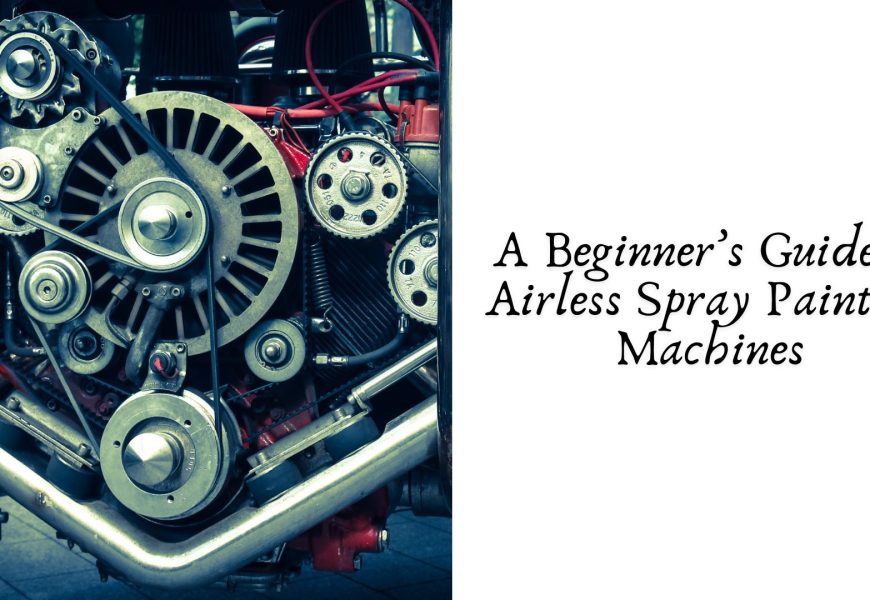Airless spray painting machines have revolutionized the painting industry, offering faster, more efficient, and precise painting solutions for both professionals and DIY enthusiasts. Whether you’re painting the exterior of a building, staining a fence, or applying a fresh coat to furniture, an airless spray painting machine can help you achieve a smooth, even finish with minimal effort. This guide will walk beginners through the basics of airless spray painting machines, how they work, their advantages, and tips for achieving the best results.
What is an Airless Spray Painting Machine?
An airless spray painting machine is a device that uses high pressure to force paint through a small nozzle, atomizing the paint into a fine spray. Unlike traditional sprayers that rely on compressed air to disperse the paint, airless spray systems rely on hydraulic pressure, allowing for higher efficiency and the ability to handle thicker materials.
The machine consists of several components, including:
- Pump: Pressurizes the paint to a high pressure (typically between 500 and 3,000 PSI).
- Hose: Transports the pressurized paint from the pump to the spray gun.
- Spray Gun: Controls the flow and direction of the paint. It features interchangeable tips to adjust the spray pattern and material flow.
- Filters: Prevents debris from clogging the tip and ensures smooth paint application.
How Airless Spray Painting Machines Work
Airless spray painting machines operate by drawing paint from a container (like a paint bucket), pressurizing it, and then pushing it through a specialized nozzle. The force of the paint being pushed through the nozzle causes it to atomize into tiny droplets, which are then evenly distributed onto the surface. The high pressure allows the machine to handle thicker paints without the need for thinning, making it ideal for large-scale projects like walls, fences, or industrial equipment.
Advantages of Airless Spray Painting Machines
- Speed and Efficiency: Airless spray painting machines can cover large areas much faster than traditional brushes or rollers. This makes them ideal for commercial painting jobs or projects where time is of the essence. A task that might take days with a roller can be completed in a few hours with an airless sprayer.
- Smooth Finish: The fine mist produced by airless spray painting machines results in an even, smooth finish with minimal brush strokes or roller marks. This is especially useful when painting intricate surfaces like doors, cabinets, or furniture where a professional, flawless finish is desired.
- Versatility: Airless spray machines can handle a wide range of coatings, from thin stains and lacquers to thicker paints and enamels. This versatility makes them suitable for various projects, whether you’re painting exterior siding, interior walls, or applying a protective coating to machinery.
- Less Waste: Unlike compressed air sprayers, airless machines waste less paint due to their higher transfer efficiency. Less paint is lost to overspray or evaporation, which means you’ll use fewer materials for the same job.
- Reduced Overspray: Airless sprayers produce less overspray than traditional methods, reducing cleanup time and material waste. However, overspray is still a factor, especially if you’re not careful, so proper masking and preparation are essential.
Getting Started with an Airless Spray Painting Machine
If you’re new to using an airless spray painting machine, here are some essential steps to get you started:
Choosing the Right Machine
When selecting an airless spray machine, consider the type of projects you’ll be working on. For small home projects, a handheld or compact sprayer may be sufficient. For larger commercial or industrial applications, a more powerful, heavy-duty machine will be necessary. Check the specifications of the machine, including maximum tip size, flow rate, and pressure to ensure it suits your needs.
Preparing the Surface
Proper surface preparation is crucial for achieving the best results. Ensure the surface is clean, dry, and free of dust or debris. If you’re painting a previously painted surface, sanding it lightly will help the new paint adhere better. Mask off any areas you don’t want painted using painter’s tape and plastic sheeting.
Setting Up the Machine
- Priming: Before you start painting, prime the machine by running paint thinner or water (depending on the type of paint) through the system to clean it out and prevent any clogs.
- Adjust Pressure: Set the pressure to the recommended level for your chosen paint. Start with a lower pressure setting and gradually increase until you achieve a consistent spray pattern.
- Choose the Right Tip: Selecting the appropriate spray tip is crucial for controlling the paint flow and coverage. Larger tips are suited for thicker materials, while smaller tips work best with thinner coatings.
Spraying Techniques
- Maintain Consistent Distance: Keep the spray gun at a consistent distance from the surface, usually around 12 inches. Moving too close or too far can result in uneven coverage or excessive overspray.
- Use a Steady Hand: Move the spray gun in a smooth, consistent motion, overlapping each pass by about 50%. This ensures even coverage and avoids streaks or missed spots.
- Spray at an Angle: For the best results, spray in straight, horizontal or vertical lines rather than arcing your arm. This minimizes overspray and keeps the paint coverage consistent.
Cleanup and Maintenance
After completing your project, it’s essential to clean the machine thoroughly to prevent clogs and ensure its longevity. Run paint thinner or water (depending on the type of paint used) through the system to flush out any remaining paint. Disassemble the spray gun, hose, and filters for a more thorough cleaning, and store the machine in a dry, safe place.
Common Mistakes to Avoid
- Not Wearing Protective Gear: Always wear safety goggles, gloves, and a mask when using an airless spray painting machine. The high pressure can cause paint to be inhaled or sprayed into the eyes.
- Improper Surface Preparation: Failing to clean or prepare the surface adequately can lead to peeling or uneven paint coverage.
- Using the Wrong Tip Size: Using the wrong spray tip can result in too much or too little paint being applied, leading to waste and an uneven finish.
Conclusion
Airless spray painting machines are a powerful tool for anyone looking to complete painting projects quickly and with professional results. Whether you’re a seasoned professional or a DIY beginner, understanding the basics of how these machines work, their advantages, and proper usage techniques will help you get the best results. With practice, you’ll master the art of airless spray painting and be able to tackle a wide range of projects with confidence.
Name: Process Control & Systems
Phone: +919051202216
Address: Modi House, Ground Floor, 14, Raja Naba Krishna Street, Kolkata – 700 005, WB, India
















